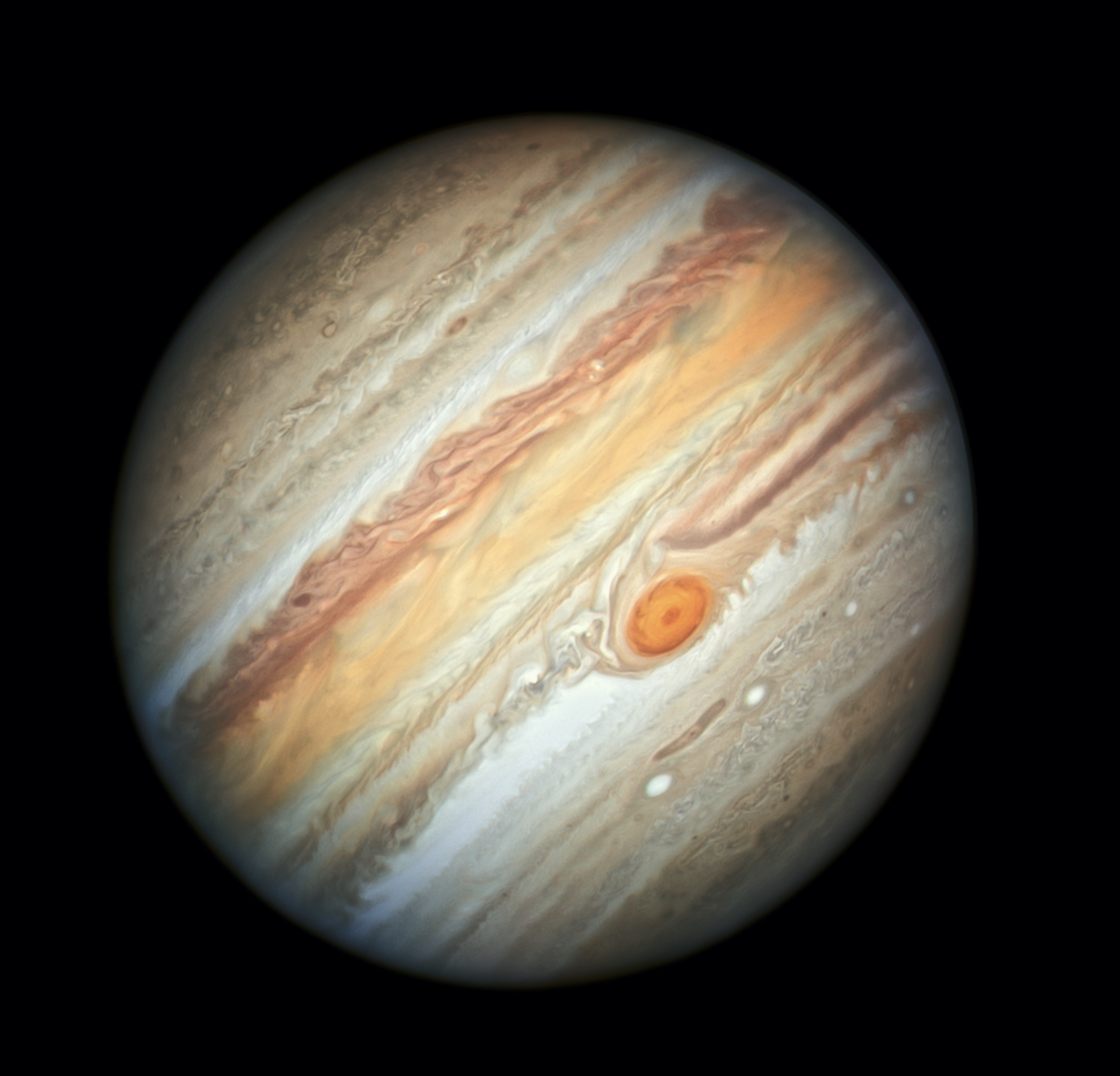Planets VSI
Planets
- p66: clouds reflect and trap heat
- p74: giant planets radiate head
- p97: a 2:1 mixture of water and ammonia is liquid at -100C
- p105: asteroid Apophis for near Earth miss projected for 2029-04-13 (Friday)
- p112: Pluto and its (relatively big) moon Charon are tidally locked
- Orbital resonance
| Planet | Mass (Earth = 1) | Density (g/cm³) | Orbit (AU) | Eccentricity | Obliquity (°) | Moons | Principal Constituents | Day Length (Earth days) | Rotation | Inclination to Ecliptic (°) |
|---|---|---|---|---|---|---|---|---|---|---|
| Mercury | 0.055 | 5.43 | 0.39 | 0.206 | 0.034 | 0 | Rock, metal | 58.6 | Prograde | 7.00 |
| Venus | 0.815 | 5.24 | 0.72 | 0.007 | 177.4 | 0 | Carbon dioxide, nitrogen | -243 (retrograde) | Retrograde | 3.39 |
| Earth | 1 | 5.52 | 1 | 0.017 | 23.44 | 1 | Nitrogen, oxygen | 1 | Prograde | 0 |
| Mars | 0.107 | 3.93 | 1.52 | 0.093 | 25.19 | 2 | Carbon dioxide, argon, nitrogen | 1.03 | Prograde | 1.85 |
| Jupiter | 317.8 | 1.33 | 5.20 | 0.049 | 3.13 | 79 | Hydrogen, helium | 0.41 | Prograde | 1.31 |
| Saturn | 95.2 | 0.69 | 9.58 | 0.056 | 26.73 | 82 | Hydrogen, helium | 0.45 | Prograde | 2.49 |
| Uranus | 14.5 | 1.27 | 19.22 | 0.046 | 97.77 | 27 | Hydrogen, helium, methane | -0.72 (retrograde) | Retrograde | 0.77 |
| Neptune | 17.1 | 1.64 | 30.05 | 0.010 | 28.32 | 14 | Hydrogen, helium, methane | 0.67 | Prograde | 1.77 |
Here’s a markdown table summarizing the atmosphere constituents, surface atmospheric pressure, and surface temperature of the planets in our solar system:
| Planet | Principal Atmospheric Constituents | Surface Pressure (bars) | Surface Temperature (K) |
|---|---|---|---|
| Mercury | Minimal; traces of hydrogen, helium, oxygen | ~0 | 100 to 700 K |
| Venus | Carbon dioxide, nitrogen, sulfuric acid clouds | 92 | ~737 K |
| Earth | Nitrogen, oxygen, argon | 1 | 288 K |
| Mars | Carbon dioxide, argon, nitrogen | 0.006 | ~210 K |
| Jupiter | Hydrogen, helium, methane, ammonia | >1000 (at 1 bar level) | ~165 K (at 1 bar level) |
| Saturn | Hydrogen, helium, methane | >1000 (at 1 bar level) | ~134 K (at 1 bar level) |
| Uranus | Hydrogen, helium, methane | >1000 (at 1 bar level) | ~76 K (at 1 bar level) |
| Neptune | Hydrogen, helium, methane | >1000 (at 1 bar level) | ~72 K (at 1 bar level) |
The “>1000” notation means that if you go deeper than the level where the pressure is 1 bar, you will reach regions where the pressure exceeds 1000 bars, much higher than Earth’s surface pressure. However, this isn’t a surface pressure in the traditional sense because gas giants lack a solid surface. The pressure just keeps increasing with depth until you reach the core, which is under tremendous pressure due to the massive overlying atmosphere.
Apophis
Asteroid 99942 Apophis is a well-known near-Earth object. Here are some key details:
- Size: Apophis is about 370 meters in diameter.
- Discovery: It was discovered in 2004.
- Close Approaches: Initially, there was concern about a potential Earth impact in 2029 due to its close approach, but further observations and calculations have ruled out this possibility. During its 2029 pass, Apophis will come closer to Earth than some geosynchronous satellites.
- Orbit: It orbits the Sun every 324 days, coming close to Earth every few years, allowing astronomers to study it in detail.
- Future: Although the 2029 impact threat has been excluded, astronomers continue to monitor Apophis to refine its orbit and assess any future risk.
Apophis is a subject of interest not only because of its size and proximity to Earth but also because it provides valuable opportunities for research on asteroid composition, structure, and how to potentially deflect hazardous asteroids in the future.
Orbital resonance
Orbital resonance occurs when two orbiting bodies exert a regular, periodic gravitational influence on each other, typically because their orbital periods are in a ratio of two small integers. This resonance can significantly affect the bodies’ orbits, often increasing their stability but sometimes leading to eccentric or inclined orbits.
Examples in Our Solar System:
Jupiter’s Moons: The moons Ganymede, Europa, and Io are in a 1:2:4 orbital resonance. For every orbit Ganymede completes, Europa completes two, and Io completes four. This resonance is responsible for the geological activity on these moons, especially Io, which experiences significant tidal heating.
Neptune and Pluto: Pluto is in a 2:3 resonance with Neptune. For every two orbits Neptune completes, Pluto completes three. This interaction ensures that, despite their orbit crossing, the two bodies can never collide.
Kirkwood Gaps in the Asteroid Belt: These are gaps in the asteroid belt where asteroids have been cleared by orbital resonance with Jupiter. When asteroids in these gaps orbit the Sun, their periods are in resonance with Jupiter’s, leading to unstable orbits that eventually remove asteroids from these regions.
Orbital resonances can thus shape the architecture of solar systems, influencing the orbits and physical characteristics of the celestial bodies within them.
Deets
- David Rothery
- Volume 254
- Published 2010
